GUIDE
An unusual name, an unusual fate, and an unusual appearance: that’s Zlatá Koruna, or “Golden Crown”, a village that used to be a monastery. Spread out over a meander of the Vltava River, today it’s a sought-after location for thousands of visitors from at home and abroad. It owes its popularity to its heritage properties, its location on the Vltava water route near Český Krumlov, and to its beautiful landscape below Kleť Mountain in the foothills of the Šumava Forest. It’s located within the Blanský les Protected Landscape Area, and the historical part of the town is even a village heritage zone featuring a number of national heritage sites. In addition to the town of Zlatá Koruna itself, the municipality today also includes the settlements of Rájov and Plešovice.
A BRIEF HISTORY
Zlatá Koruna’s beginnings are directly associated with the local Cistercian monastery. It was founded in 1263 by the Czech King Přemysl Otakar II. According to the old monastic tradition, he founded it to commemorate the victorious Battle of Kressenbrunn, which he successfully led against the Hungarian army of Béla IV in the year 1260. The monastery’s establishment was also certainly led, however, by geopolitical and economic reasons. Monks from Austrian Heiligenkreuz were entrusted to establish the new monastery community, being in the spirit of the king’s policy of interconnecting the Czech lands with his newly acquired Danube region. The foundation of the monastery in South Bohemia, however, also signaled an active encroachment into a space that was being increasingly dominated by the powerful local noble house of the Vítkovci.
The considerable amount of land owned by the monastery, originally named Sancta Spinea Corona (Holy Thorny Crown), provided the funds for its generous Gothic architecture during the 14th century. The feudal crisis which started out in the early 15th century and grew into the protracted armed conflict of the Hussite War, affecting all of Bohemia, did not spare Zlatá Koruna. In 1420, the Hussites attacked the monastery twice and temporarily crippled its monastic life. During the changed circumstances of the 15th and 16th centuries, the Cistercians were unable to defend their property from aggressive nobles, particularly the Rožmberks, who robbed them of their land and attached the monastery to their own family belongings. Until the beginning of the period of re-Catholization after 1620, the monastery teetered on the verge of collapse. The later period of stabilization was not significant here in comparison with other Czech monasteries, however, manifesting merely in gradual Baroque modifications of the monastery complex. In the 17th and 18th centuries, the monastery’s activities mostly focused on supporting the Marian cult in nearby Kájov, whose parish there fell under the care of the Zlatá Koruna Cistercians. Despite the enlightened reforms of the last abbot Bohumír Bylanský, the monastery was abolished in 1785 by Emperor Joseph II. The main temple became a parish church while the other shrines were closed. The village of Zlatá Koruna was established, known in German as Goldenkron. The estates were acquired by the princes of Schwarzenberg, who rented out the artistically most valuable monastery buildings for industrial purposes. The premises successively housed a match factory, a textile factory, and a foundry with a machine shop. From 1908, the Schwarzenberg family began salvaging the most important parts of the premises. After 1940, when the Schwarzenbergs were effectively deprived of exercising their property rights by the Nazis, the state continued to implement repairs to the former monastery. In the meantime, the village (initially closed in by the outer walls of the larger monastery area) developed into a township whose historical part is now spread over the meanders of the Vltava River. Nowadays, the modern section of the town continues to develop high above the river, near the railway station.
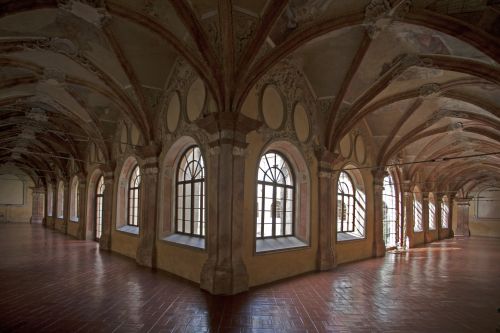
PLACES TO SEE & VISIT
Zlatá Koruna is situated on an internal meander of the Vltava River, away from the larger settlements and main roads. By choosing this location to establish their monastery, the monks of the Cistercian order satisfied the ideal demand of being able to concentrate more on serving God and remaining detached from the superficial world of people. The monks created a self-sufficient spiritual and economic unit for their work in the spirit of the motto of St. Benedict, “ora et labora” (pray and work). The entire area inside the meander gradually filled with the monastery buildings, arranged in a more or less logically interconnected whole. The nucleus of the complex was always the temple with its adjacent convent building, built on a square ground plan. The abbot’s facilities, hospital, and guest rooms were included as well, while the agricultural buildings were built directly adjacent. Water played an important role in the life of the monastery, both for practical and symbolic purposes. Water was taken from the Vltava River, but the monks also led a roughly 3 km long manmade canal along the ridge of the peninsula, called the Jordánek, or the little Jordan. The environment of this quiet little meandering valley of the Vltava River was an excellent choice for founding the monastery; the only compromise that the terrain demanded was that the presbytery of the main temple could not face the east, as was the custom in Christian church architecture. After the Hussite Wars, monastic life became increasingly concentrated into the core of the monastery, while all other activities in the outer enclosure were secured by lay workers. This outer area of the former monastery gradually evolved into a village of the same name. The historical part of the village of Zlatá Koruna is spread out over the site of the former monastery; taken as a whole, this is the largest monastery complex in the Czech Republic.
The monastery complex
The Zlatá Koruna Monastery was declared a national cultural heritage site in 1995. It consists of the core of the monastery with the Church of the Assumption of the Virgin Mary, the convent buildings, the abbot’s house, and the adjacent gardens. The premises containing the most valuable monuments also include a former agricultural courtyard and the buildings around the Gothic entrance gate – the municipal office and the former parsonage. The artistically most valuable parts of the former monastery are presently in the care of the National Heritage Institute. The monastery interiors, together with the parsonage and what was once the main monastery church, have been carefully renovated with the monastery furnishings and are now part of visitor tour routes.
Church of the Assumption of the Virgin Mary
The most important building in Zlatá Koruna is the Church of the Assumption of the Virgin Mary. This three-nave basilica with a transverse nave is the largest sacred structure in South Bohemia. It was built in two stages sometime between 1280 and 1360; the construction likely began at the intersection of the main nave with transept and ended with the construction of the entrance section. The walls of the church bear visible traces of the external buttress system. This is the oldest evidence of a cathedral design with a support system using gablets in Bohemia, but it was never actually carried out. In 1420, the church was destroyed by the Hussites and remained in ruins until the 1760’s. Subsequent Early Baroque modifications involved removing the fourth nave; the church was mostly fitted with new lowered Baroque vaults, and many of its numerous medieval artifacts were removed. Still, the Gothic rosette and the front Gothic window represent an excellent example of High Gothic architecture in Bohemia. The costly Late Baroque reconstruction of the church that began after the middle of the 18th century under the last abbot Bylanský stopped at the level of the transverse nave with the abolition of the monastic order. The presbytery with the altar of the Assumption of the Virgin Mary and with later statues of the church fathers was completed, together with the cenotaphs of Přemysl Otakar II and donor Bavor III as well as other painting and sculpture works. A rare monument, one of high sacred significance for the faithful, is the Gothic painting of the Zlatá Koruna Madonna from the first third of the 15th century. It is part of a circle of Madonnas in the “beautiful style” as represented by the Madonna of St. Vitus. A copy is presently located in the church, since the original Madonna has recently found a new home in the abbey chapel. After the abolition of the monastery in 1785, the monastery church became a parish church and the Schwarzenbergs assumed patronage. In the 1940’s, the Schwarzenbergs sought a dignified place in their estates for storing the remains of their deceased family members. Before deciding to build a new tomb in Třeboň, they also considered Zlatá Koruna. Proposals for a Neo-Gothic reconstruction of the church with a massive tower in the front also come from this period. When this prospect was finally abandoned, a reconstruction was carried out which ended up being rather unfortunate for the silhouette of the church. The bell tower, too heavy for the roof, was removed from the main church intersection, and the Gothic gables and roof obtained their present low slope. In order for the church to not lose its medieval character, the Gothic elements were returned to the newly constructed gables, but the visible aspects of the church were seriously damaged. This reconstruction took place in 1839-1841. Other proposed reconstructions, sometimes quite radical, were fortunately not carried out.
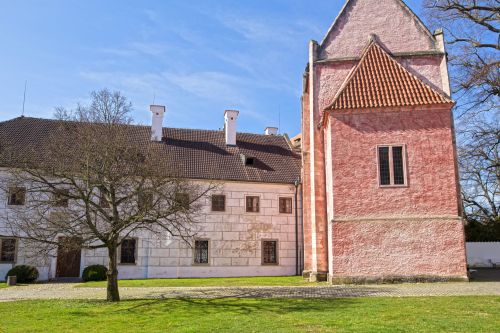
Large convent
The ambit was architecturally connected with the church; its layout was binding and unchanged in most medieval monasteries of Western Europe. The quadrature of the convent, designated in Zlatá Koruna as large to distinguish it from the small convent of the former hospital, is still well preserved. The construction of the ambit took place simultaneously with the construction of the main church. The architecture of the cloister, containing 28 cross vault arcs and a capitulary hall from the first third of the 14th century, is graciously combined with Rococo stucco and frescoes from the time of the last Abbot, Bylanský. The damage to the paintings and demolition of the well chapel inside the paradise court in 1828 is due to industrial operations. At that time, the great convent was converted into a textile factory, then into a steel mill and a machine shop from the middle of the 19th century. The damages caused by the factory in the monastery buildings were mainly limited to the interior decorations. Since 1908, when the factory was considered no longer viable and was closed, restoration work was carried out which returned the building to its appearance as before 1785. The main part of the sightseeing tour for visitors passes through the large convent. Today the interiors of the large convent partially evoke the period before the abolition of the monastery. The refectory, library, and several cells are decorated to remind us of the spiritual life of the monastery. A unique set of didactic pictures of the Zlatá Koruna monastery school from the second half of the 18th century is exhibited in the former monastery kitchen. The tour route passes through other areas and the exteriors of the former monastery, such as the small convent, the main church, and the abbey chapel.
Small Convent and Chapel of the Guardian Angels
The small convent received its name at a time when it served as the main dwelling of the monks, when monastic residency was very low following the Hussite wars. The building itself reveals several building phases from the late Gothic to the final period of when monks still lived in the monastery. Originally there was likely a hospital here that was closely linked to the neighboring chapel of the Guardian Angels. This is the oldest architectural heritage building in Zlatá Koruna. Its origins date back to the last quarter of the 13th century, and some researchers consider this to be from the first decade of the monastery’s existence. The chapel is two-storied; its original pentagonal presbytery did not survive, so the present presbytery is only from the 20th century. The chapel with small convent underwent great changes in the 19th and 20th centuries, when they were both repaired as part of several waves of varying heritage conservation approaches. The chapel, however, saw its larger modifications soon after the abolition of the monastery, when it no longer served as a sanctuary. First, the chapel of the Virgin Mary was demolished, as was the sacristy on the other side. The clock tower was then dismantled and transferred to the nearby Schwarzenberg chateau Červený Dvůr. The church experienced its most difficult loss in the 1840’s, when the presbytery was an obstacle to the expansion of the former factory yard and was therefore demolished. Today’s annex of the chapel dates back to World War II. The red color of the facade of the building is a modern reconstruction based on the oldest layer of plaster from the Middle Ages.
The artistically most valuable architectural element is the Early Gothic portal at the western entrance to the chapel. A valuable stone tympanum with carved wine leaves refers to the bond of this Cistercian monastery to the beginnings of the Citeaux (Latin Cistercium) in Burgundy. The ground floor of the church is currently used for occasional worship and has recently been equipped with a late Gothic wing altar, the so-called Němčice Arc, and with a cycle of Gothic paintings based on the theme of the martyrdom of the Kájov apostles. The upper floor of the chapel now serves as a depository of manuscripts and engravings owned by the South Bohemian Research Library.
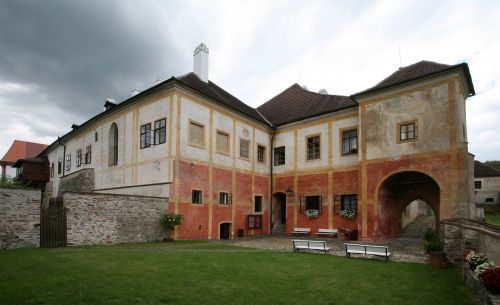
Abbey, courtyard and brewery
The set of buildings framing the most spacious courtyard in Zlatá Koruna from the north and east sides is now referred to as the abbey. The tract built over the river floodplain on the eastern side, however, served mainly as the abbey. The monastery brewery was adjacent to it to the north. This building has a complex architectural development in which all architectural styles alternate, from the Gothic to contemporary heritage conservation. The Gothic penetrates the building from the deep cellars to the first floor, where the most valuable central abbey chapel is built on an octagonal ground plan. Today it is home to the original Zlatá Koruna Madonna. Renaissance and Baroque modifications gave the whole building its picturesque appearance with a labyrinth of corridors and narrow spiral stairs.
To represent the abbot according to the tastes of the period, the courtyard was gradually modified to a symmetrical honorary courtyard headed by the abbot’s dwelling. For these purposes, the old wall was partially demolished in the 18th century and a gate was inserted. The original vehicle entrance was north of the brewery tract. The expanding and prosperous brewery and its operations did not coincide with the ostentatious arrival area to the monastery, so the solution was to create this honorary courtyard. The brewery closed its activity at the same time as the monastery was abolished, and the spaces along the current entrance to today’s ticket office on the northern side of the premises used by the brewery became a service access road in the 19th century. Due to their poor technical condition, the Baroque pharmacy and the library above the passageway, the Baroque tract of the abbey over the river, and the old abbey kitchen with its tall flue were demolished at the end of the 19th century. Today, the complex contains the administration building with technical utilities; there are also exhibition spaces, the ticket office, there is a department of historical book collections of the South Bohemian Science Library, and the monastery complex also has revived a kindergarten, popular among parents from Zlatá Koruna as well as from the nearby surroundings.
Gardens
The Baroque panoramic views of the monastery were highlighted by the Baroque ornamental and utility gardens that surrounded the monastery complex. Three larger gardens stood out in particular. The kitchen and supply garden that adjoined the monastery kitchen, the ornamental garden of the convent, and the very elaborate abbey garden located behind the tract of the abbey house and the brewery. The convent garden, as the name shows, served for the recreation of the entire convent staff, while the abbey garden was accessible by the abbot in particular, who also gave access permission to other members of the monastery and the pupils of the local exemplary school. The ornamental gardens were also equipped with fountains and were modified to imitate a regular French garden. After the abolition of the monastery there was no one to take care of the gardens, so today there is nothing left of their intricate Baroque arrangements. Today all these landscapes are maintained as gardens, mostly containing orchards. While the convent had 34 members and several dozen agricultural workers and subjects who were to the monastery by their feudal dependence, the monastery today is tended to by only 5 employees equipped with the essential technology.
Historical part of the town
A visitor arriving in Zlatá Koruna today will perceive the village and the monastery separately, but this division did not apply in the past. From the time of the monastery’s establishment until 1785, this valley held only the monastery. It was only after its abolition that the village was built on the outskirts while the Schwarzenbergs acquired the inner complex, followed by confiscation by the state. This substantially divided the fates of both parts of what was originally a unified urban structure.
The village and its economic development
Cistercian monasteries tried to be self-sufficient, so they founded hop gardens and vineyards, among others. The beer from the local hops was brewed by the monks in the monastery brewery, located in Zlatá Koruna near the abbey house. In addition to this brewery, the monastery also had two other breweries in its possession before its abolition (in Chlumeček near Křemže, and in Keblany near Trhové Sviny). The first residences were built only during the Baroque, against the medieval monastery wall. They were resided in by the families of the monastery employees, thus creating the basis for a permanent village settlement inside the monastery walls. After the abolition of the monastery, the settlement became denser, and by 1827 the number of local buildings had tripled. This population increase was directly related to the job opportunities that emerged from 1801 in the newly established manufactories and the later factories in the large vacated buildings of the former monastery. The building in the middle of the historical part of the village is of medieval origin, as is visible from the stepped gables, and it is still preserved in nearly its original appearance. It served as a hospice, which was a house for pilgrims and other sick people who were not members of the monastic order. Later, the Schwarzenbergs converted it to a princely inn and tavern, and now the building houses the post office and a few dwellings. Nearby there is what used to be the monastery granary, still standing on the village square today. It is of Baroque origin and dates back to 1686.
The premises of this national heritage property also include the former agricultural courtyard, founded by the monastery in the 16th century at the latest. Before the Hussite wars, it was likely located in an elevated position in the middle of the fields in the upper part of the village where the modern housing development stands today, but nothing remains of its original medieval structure. These farmyards were used by the Schwarzenbergs after the abolition of the monastery and later by local landowners. They served their purpose until their collectivization in the middle of the 20th century. This complex of the agricultural courtyards consists of an aggregate of buildings ranging from the 16th to the beginning of the 20th century.
Behind the granary, in the last years of the monastery and during the first decades after its abolition, stood a canvas-bleaching facility which the monastery also used to supply the state for military purposes. Another source of income for the monastery was the production and sale of saltpeter (potassium nitrate) and potash, which was prepared in operations around the granary. Saltpeter was mainly used for the production of gunpowder, while potash served in the production of glass in nearby Šumava glassworks. After the abolition of the monastery, this production was expanded here in Zlatá Koruna, partly under the direction of the state and partially operated by the Schwarzenbergs. Saltpeter and potash production persisted here until the middle of the 19th century.
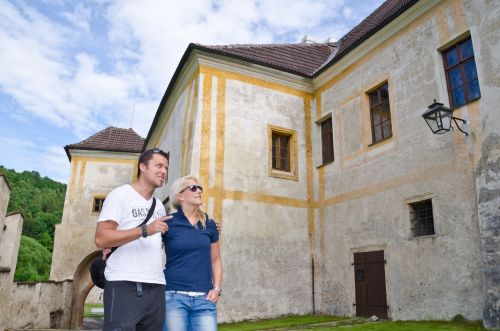
Parsonage, gate, and the municipal office
Next to the present municipal office, the main gate was the entrance to the inner part of the monastery, which today is a national heritage property. The gate is Gothic and was originally guarded by a Gothic bastion, later rebuilt and modified several times. During the monastery’s decline in the 16th century, the abbot also lived in the bastion. At that time, it was decorated with Renaissance rustic design, which is still preserved. The bastion was one floor higher until 1836. Until the 1840’s, there was a kitchen with a tall flue directly adjacent to the bastion. Today, a neo-Renaissance annex from the 1890’s stands on its site. After the abolition of the monastery, the bastion was adapted for the needs of the newly founded parish. The priests and chaplains lived here until the 1970’s. Opposite, near the gate, there stood a gatehouse during the period of the convent monastery, the gatekeeper lived here (usually the oldest member of the convent), and there was also a small spa. After the abolishment of the monastery in 1787, the building was modified for the needs of the renowned Zlatá Koruna school. The school’s faculty included the Revivalist teacher Antonín Borový (1755-1832), writer, friend of Václav Matěj Kramerius, and composer of church hymns.
Church of St. Margaret and the gate
During the period when the monastery was in operation, pilgrims entered by way of the first gate and to the Church of St. Margaret (Markéta). Legend claims that this church is older than the monastery, but in fact it dates back to the 14th century. At the end of the 15th century it was rebuilt in Late Gothic style with two naves. It was a place of worship for the faithful from the monastery’s surroundings as well as for those living and working in the artisan houses inside the monastery walls. Access to worship in the main monastery church was not possible, because the monastery was governed by the principles of enclosure; only members of the convent and other specifically selected persons were permitted into the monastery premises. The church was closed soon after the abolition of the monastery. The building then had a variety of uses, mostly economic. From 1843, the Fürth company, later transformed into world-renowned Solo Sušice, produced matches here. Matchstick production in Zlatá Koruna terminated in 1902, then the Schwarzenberg forest administration housed forest workers here, and today the building is empty. Each change in the building’s function brought about reconstructions, of course, so at the end of the 18th century the Baroque tower was dismantled and transferred to the newly built church in Hodňov na Šumavě. The dome on this church still bears the Roman numeral XIV, which indicated the Zlatá Koruna Brotherhood of 14 holy helpers. The body of the original Gothic tower, which preceded the Baroque tower, is still preserved above the former triumphal arch in the current attic of the church at about 4 meters high. At the end of the 18th century, the vaulting was demolished, and after a fire in 1854 the building was completely rebuilt and expanded. Today, the Gothic corners emerging from building are a peculiarity. The late Gothic gate nearby reminds us that the monastery was surrounded by a light defensive wall. Unfortunately, the gate was pulled down and removed in 1960 during a military exercise.
Mill, weir, and millrun
The monastery built a mill at the edge of the valley floodplain of the Vltava River. It first served for grinding flour, then it expanded to include a sawmill. The first mention of the mill comes from the Middle Ages, and from 1686 we have a clearer idea of its location. The mill was connected to a weir with a millrun, which are also documented to this year. The weir, supplemented by a small hydroelectric power plant, still stands today; it is well-known by all rafters passing down the river around Zlatá Koruna. Presently, rafters and canoers use the sluice with fish retarder, but until recently there was a wider and shorter voracious passage here designed for wood raft transport. At the time of its greatest glory from the end of the 19th century to the WWII, Zlatá Koruna and especially Rájov were a famous demonstration site for wood rafters.
The mill burned down at the beginning of the 19th century, and after its reconstruction it significantly expanded to its present appearance. The flour mill equipment from the beginning of the 20th century, referred to as the “American system”, is still preserved. The millrun from the mill continued through the still existing mill canal as well as through the rather massive vaulted canal which brought water under the Baroque tract of the monastery and served as a sewer line for the monastery and its inhabitants.
Today, the most common arrival route to Zlatá Koruna is via the Vltava Bridge, which was built in the early 19th century and is relatively young. Prior to its construction, the main roads to the monastery led along the left bank of the river, but mainly from the upper part of today’s village.
Entrance to the historical part of Zlatá Koruna and the Jordánek Creek
The divide between the modern and historical part of the village is made up by a steep slope called Kotrbíz, where the main road to the monastery always led. This rather odd name is a Czech word play on the old German name of the meadows above the monastery (Gotteswiese) and is reminiscent of the cemetery which existed here about a hundred years after the abolition of the monastery; today only the massive stone wall survives. Long before the cemetery existed here, the monks dug out a ditch from the forest on the slopes of Kleť mountain to bring clean spring water to the monastery. This manmade canal still exists today. It is three kilometers long, and since the monastery times until today, it has been named in the spirit of the biblical symbolism of the Jordan River as the Jordánek, or Little Jordan. The artificial canal running along the ridge of the narrow promontory distributed water to all monastery facilities that could not be connected to the Vltava River. Not far from the railway station on the plateau above Kotrbíz, where the modern part of Zlatá Koruna is today, the canal was connected to a sheepfold and a fishpond. Beneath the slope that separates the upper and the historic part of the village there stood a house still called “U fišmajstra”, or the “fish master’s”; it used to be a small flour market. The Jordánek entered the monastery complex at the former church of St. Margaret and continued on to supply some monastic houses where the craftsmen who worked for the convent lived. The water eventually flowed from the canal into a produce-cooling pond or the abbey pond. From here, in still partially-preserved pipes, the water fed the agricultural and ornamental gardens.
The existence of today’s hidden canal near the monastery is also commemorated by the Baroque statue of St. John of Nepomuk. Sculptures of this saint were symbolically almost always placed on bridges or at least near waterways, such as the Jordánek.
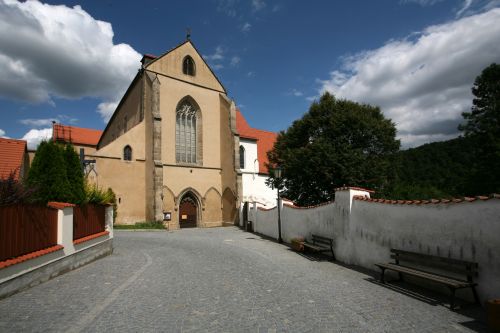
AROUND ZLATÁ KORUNA
Zlatá Koruna is much more than a former monastery complex. Near the originally distant Zlatá Koruna railway station leading from České Budějovice towards Šumava, built in 1891, a community of family houses emerged, occupying the plateau high above the historical part of Zlatá Koruna.
The municipality of Zlatá Koruna also includes two villages, Rájov and Plešovice. Both smaller settlements are also renowned to canoers, rafters, and hikers. Rájov especially as a popular water-stop, and Plešovice especially as a crossroads for hiking trails between Zlatá Koruna, Kleť and the castle ruins of Dívčí Kámen.
Rájov is located less than 1 km from Zlatá Koruna. It originated at the beginning of the 14th century at the latest, and its history has always been associated with an important roadway from Ceske Budejovice to Český Krumlov at a river ford and later by the bridge over the Vltava River. Since the Middle Ages, it has been a location for collecting tolls, and at the time it was a large and wealthy village. At present, the dominant landmark of Rájov is the reconstructed roadside in and tavern Na Kovárně. The name means “at the iron forge” and it used to house a forge in the middle of the village.
The village of Plešovice is located about 1.5 km from Zlatá Koruna. The railway line passes through here on the route České Budějovice - Černý Kříž - Volary / Nové Údolí. The village also includes a nearby granulite quarry which is one of the largest in the Czech Republic. Plešovice is a picturesque South Bohemian village situated at the foot of Kleť Mountain. The round village green is surrounded by traditional farmhouses, some of which are adorned with spectacular wing gables in the spirit of the South Bohemian Baroque.
Author of the text: Mgr. Jindřich Špinar
Adresa obecního úřadu
Zlatá Koruna čp. 41,
382 02 Zlatá Koruna
Úřední hodiny
po 7:00 - 11:30, 12:00 - 17:00
st 7:00 - 11:30, 12:00 - 17:00
Kde nás najdete
Powered by ANTEE - Web Design, Content Management System IPO




